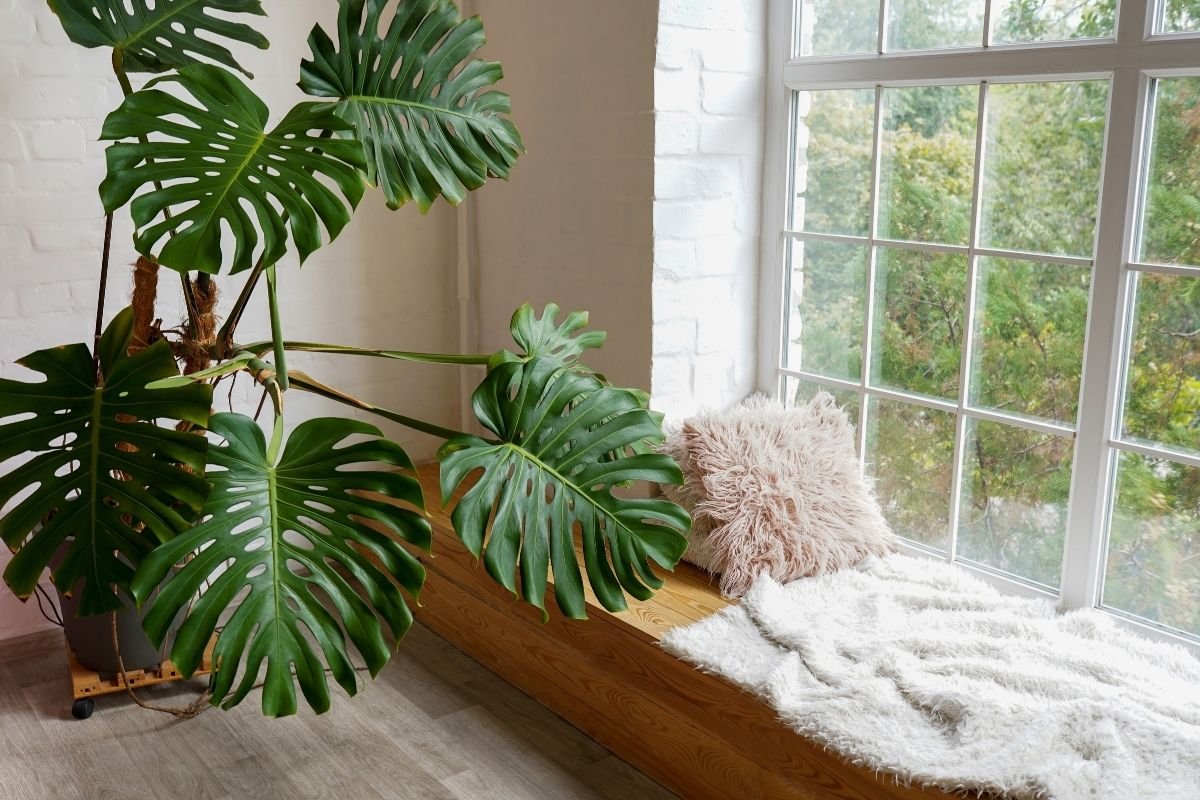Most plant owners struggle to provide enough light for tropical plants like monstera, but did you know that this equatorial climber can also suffer from too much light? It’s true! In this article, learn all about the lighting needs of the popular swiss cheese plant and common signs that your plant is suffering from too little, or too much light.
Monstera is loved for its large, feathered leaves. Many indoor gardeners overlook the lighting needs of this plant because it grows quickly in most environments (finding enough space for this plant in your home or workspace is the first challenge for many!). Providing adequate light conditions is essential to growing your healthiest monstera though, so listen up folks!
All plants have their preferences for lighting based on where they originate. monstera, which are vining plants native to Central and South American rainforests, grow in the understory along tree trunks. While the lighting preferences of monstera vary slightly by species, they generally prefer consistent, bright, indirect light.
how much sunlight does a monstera need?
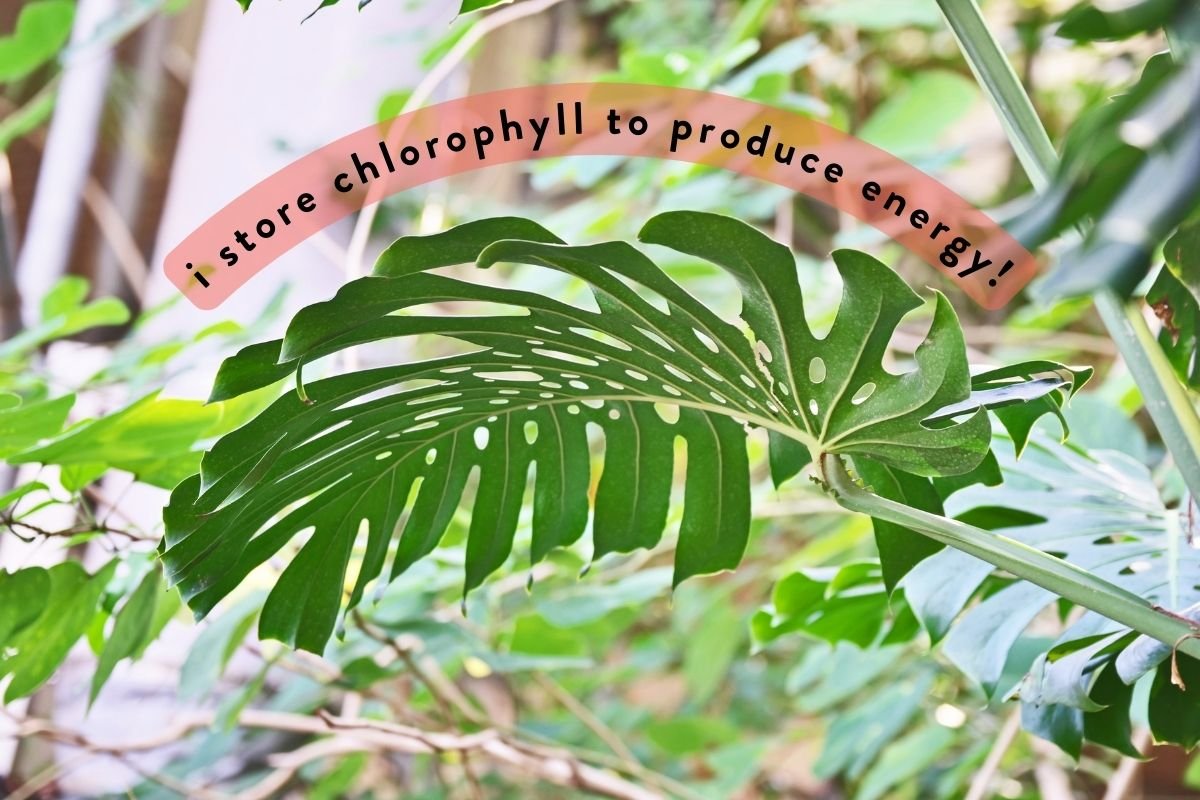
The vibrant dark green of monstera leaves comes from its high chlorophyll content. Since these plants are used to spending time in the shade of a rainforest canopy, monsteras make and store as much chlorophyll as they can to produce energy in the shaded conditions.
When placing your monstera indoors, find a spot that doesn’t get direct sunlight but that does get plenty of bright, indirect light. These plants do best in north or east-facing windows: a window that faces the north will get low to medium light, since (in the northern hemisphere) the sun sits further to the south. Windows that face the east get some direct sunlight in the morning, but lots of indirect light in the first half of the day.
A monstera plant wouldn’t do as well in a south-facing window, which gets some direct light in both the morning and afternoon. The least suitable spot for a monstera would be in front of a west-facing window, which would expose the plant to direct light and risk burning its leaves.
how many hours of light does a monstera need?
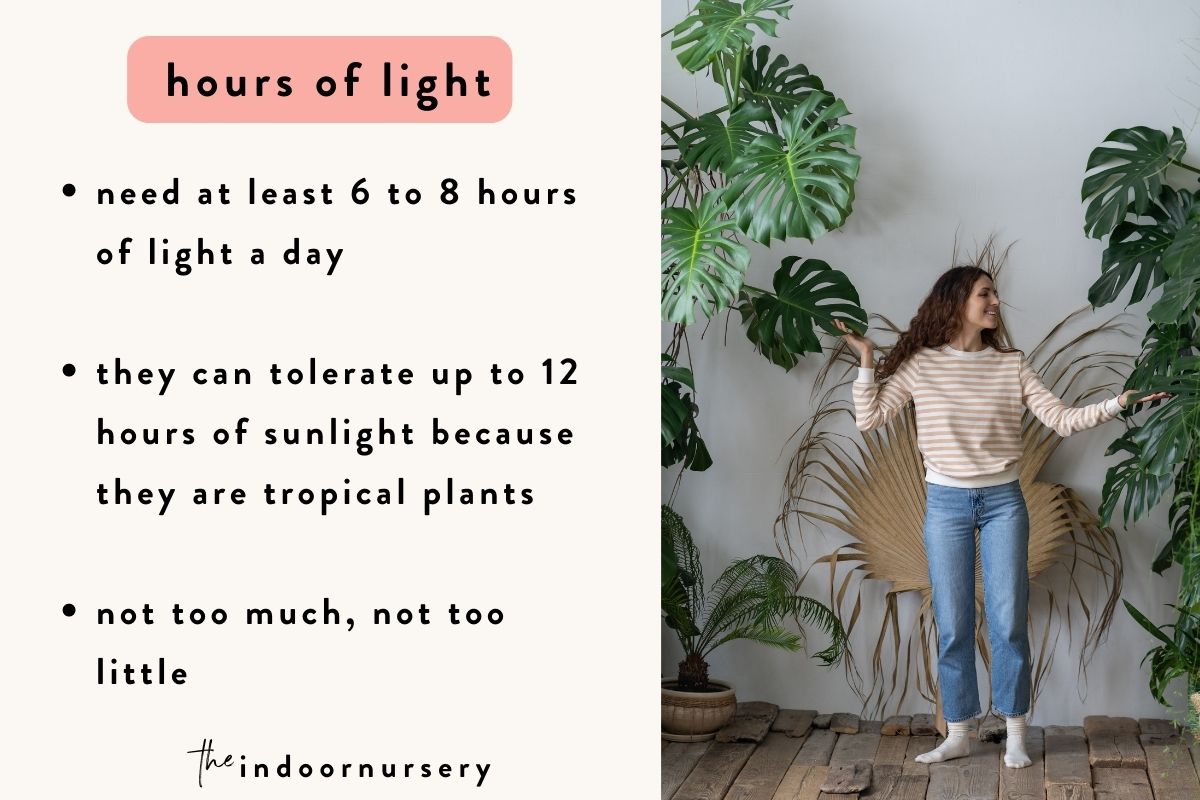
Like most plants, monstera needs at least 6 to 8 hours of light a day. Since they are tropical plants, they can tolerate up to 12 hours of sunlight. More than that, however, isn’t better for this jungle plant: it prefers not too much and not too little. In extreme seasonal climates, monstera appreciates a few additional hours sunbathing in a grow light when daylight hours are limited.
how do you know if your monstera is happy?
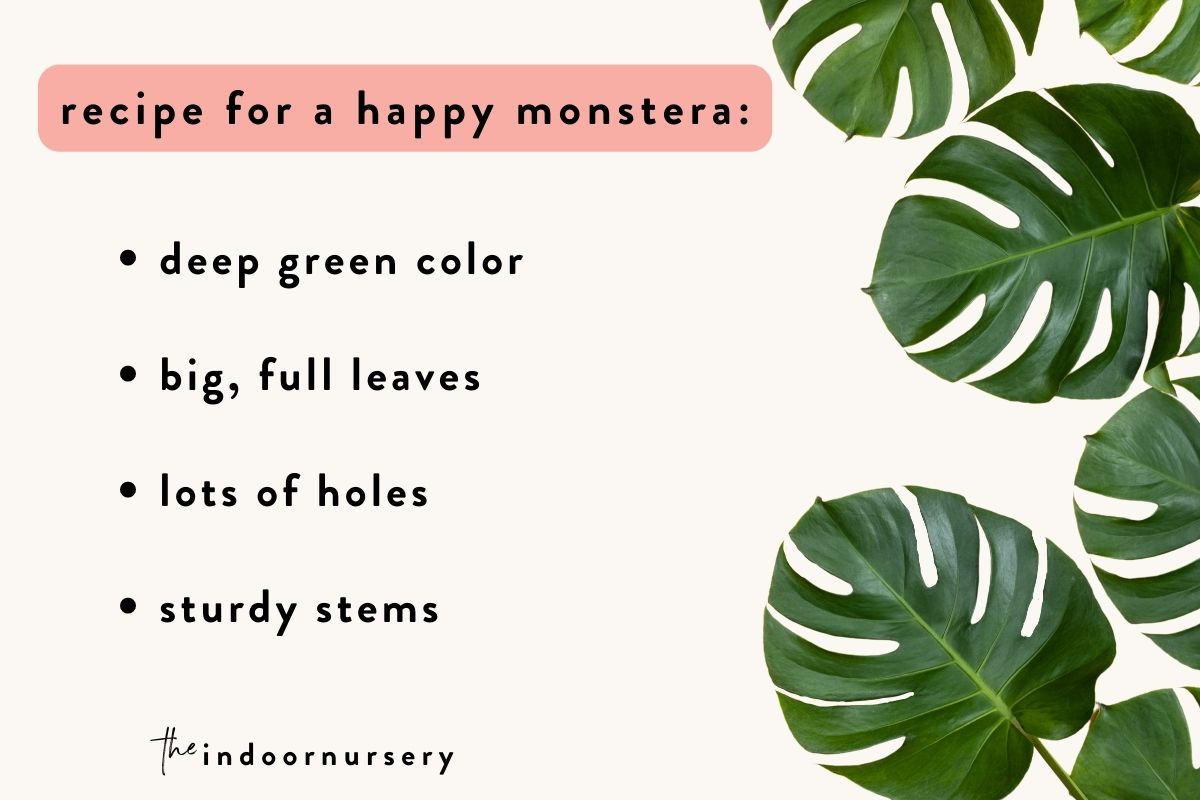
When cared for properly, a healthy monstera radiates a vibrancy that makes any space welcoming and peaceful. Here are some signs that your monstera is getting enough light (and not too much!):
- deep green color. Most monstera plants have a deep, dark green color that comes from their high chlorophyll content. The right amount of indirect light throughout the day helps the plant make enough energy to keep the plant’s leaves firm and green, a sign of a healthy plant. The exception, however, is variegated or silver varieties of monstera, which have white or silvery patterns that, if they get too much light, can turn green.
- big, full leaves. One of the most appealing features of monstera is their large, leathery leaves that, in rainforest conditions, grow on very long vines that can reach up to 60 feet. The huge leaves absorb as much sunlight as they can to make up for the shady conditions. Big, waxy leaves are a sign of a healthy plant that’s getting enough light and perhaps a good dose of monstera fertilizer.
- lots of holes. Young monstera plants actually lack the iconic holes that the species is known for. These fenestrations develop as the leaf matures, and the bigger it gets, the more holes it develops. A healthy, mature monstera has slits along the edges and interior holes as well. There are many theories about why exactly monstera is so hole-y: one theory is that these holes provide wind resistance in stormy tropical weather. Another is that they allow light to penetrate leaves below since, in nature, they stack up as they climb and would otherwise block light from reaching below.
- sturdy stems. As a climbing plant, monsteras have vines that normally latch on to bark and moss on forest trees. Their stems transport moisture, nutrients, and energy throughout the plant from their soil-based roots and aerial roots all along the vines. As a houseplant, if a monstera doesn’t have a moss pole or another surface to climb, the stems have to support the heavy leaves on their own. Without this support, healthy monstera leaves will grow vertically from their main stem – even though the main stem might spread out across a surface.
you might also like: here’s the best soil for monstera plants
how monstera reacts to different lighting
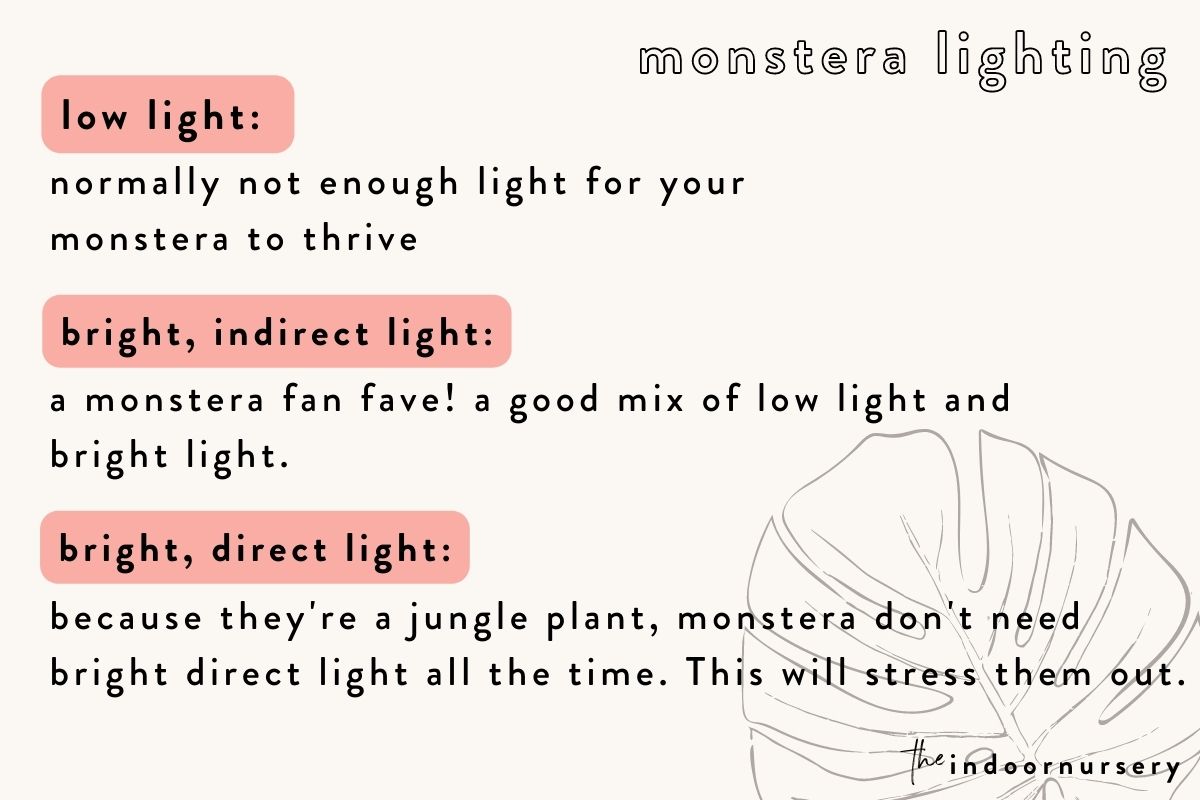
The understory habitat where monstera originates has conditioned these plants to be most comfortable in bright, indirect light. They typically climb up tree trunks in the open air, receiving unobstructed indirect sunlight. This is in contrast to ground-level plants that might be shaded by medium-sized plants as well as the canopy cover.
low light
While monstera plants are indeed used to shade, they still need some amount of light to thrive. There are several signs that a plant isn’t getting enough light, like producing small leaves and weak stems or leaning towards a light source. A north-facing window, or a room with small windows, might not give your monstera enough light year-round.
If your monstera isn’t getting enough light, move it closer to a window, or move it to a brighter room with more indirect light. You can also use a grow light to supplement the natural light if moving the plant isn’t an option.
bright, indirect light
Monsteras love lots of bright, indirect light. This is the kind of light that fills the room, but not from direct sunshine. Monsteras make the best of the situation in their natural habitat, climbing tree trunks for as much light as they can get even though the canopy tops will block a lot of the direct sunshine.
Their leaves are efficient in the shaded spaces, which makes them able to tolerate some low light conditions, but when they get enough light, they will stay in place and grow big leaves to take advantage of the lighting opportunity.
bright, direct light
Since Monstera grows under the shade of a forest canopy, they aren’t used to much, if any, direct sunlight on their leaves. Too much direct sunlight will dehydrate the leaves and can even burn them, resulting in yellowed or brown edges, wrinkling, or curling.
Too much heat from direct light will stress out your plant, and plants with stressed leaves are less able to make the energy they need to stay firm and sturdy. If your monstera is exposed to too much direct light, it may droop, wilt, and lose its leaves.
If you see those signs of stress, but can’t move the plant, consider curtains or shades to block the sunlight during the hours when the sun would be shining directly on the plant.
signs your monstera needs more light
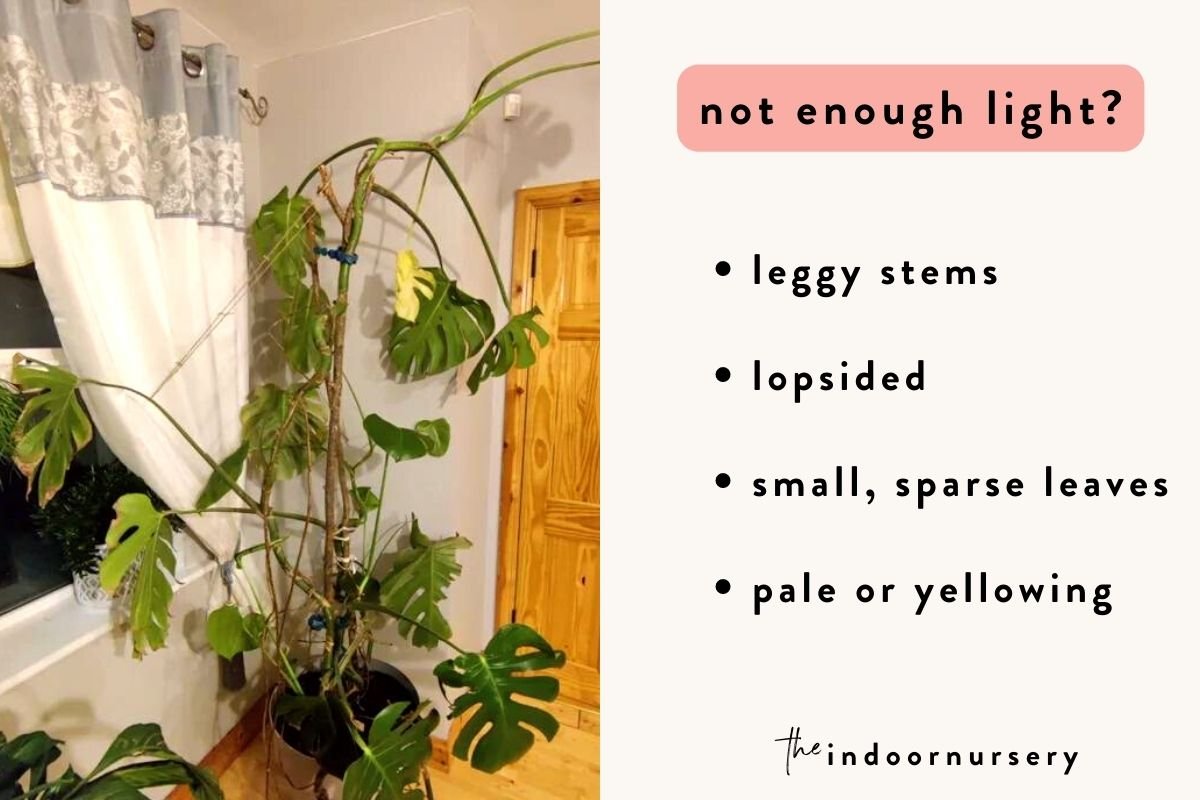
There are a few telltale signs that your monstera isn’t getting enough light. If you notice your plant displaying any of them, move it into a space with more bright, indirect light:
- leggy stems. While monstera plants are vines and have somewhat long stems in the first place, a plant that isn’t getting enough light will have extra long stems to reach for more light. Long stems with few or small leaves are a classic sign of too little light.
- leaning to one side. Like leggy stem growth, a plant that isn’t getting enough light will reach all of its stems in the direction of the strongest light source when sunlight is scarce. This might be a window that the plant is too far from, or a full spectrum LED bulb that is giving more light than any window in the room. Rotating a plant in sufficient light can help prevent lopsidedness and keep leaves on all sides of your plant growing robustly.
- small, sparse leaves. If your plant isn’t growing very quickly or it isn’t producing new leaves, it may not be getting enough light. Plants reduce leaf production to save energy in dark conditions, so new leaves that remain small and don’t develop the signature swiss cheese holes typically indicate that the plant isn’t able to spare the energy to grow them to maturity.
- pale or yellowing. Without enough light, a monstera may start to pale and turn yellow from not being able to produce enough chlorophyll. Since they make their own supply from nutrients and light, a certain amount of light is necessary each day for plants to make chlorophyll and photosynthesize to store energy for the night. In dark conditions, a plant can’t keep up with its own energy needs, and the cells containing chlorophyll will die.
but what if my house isn’t light enough?
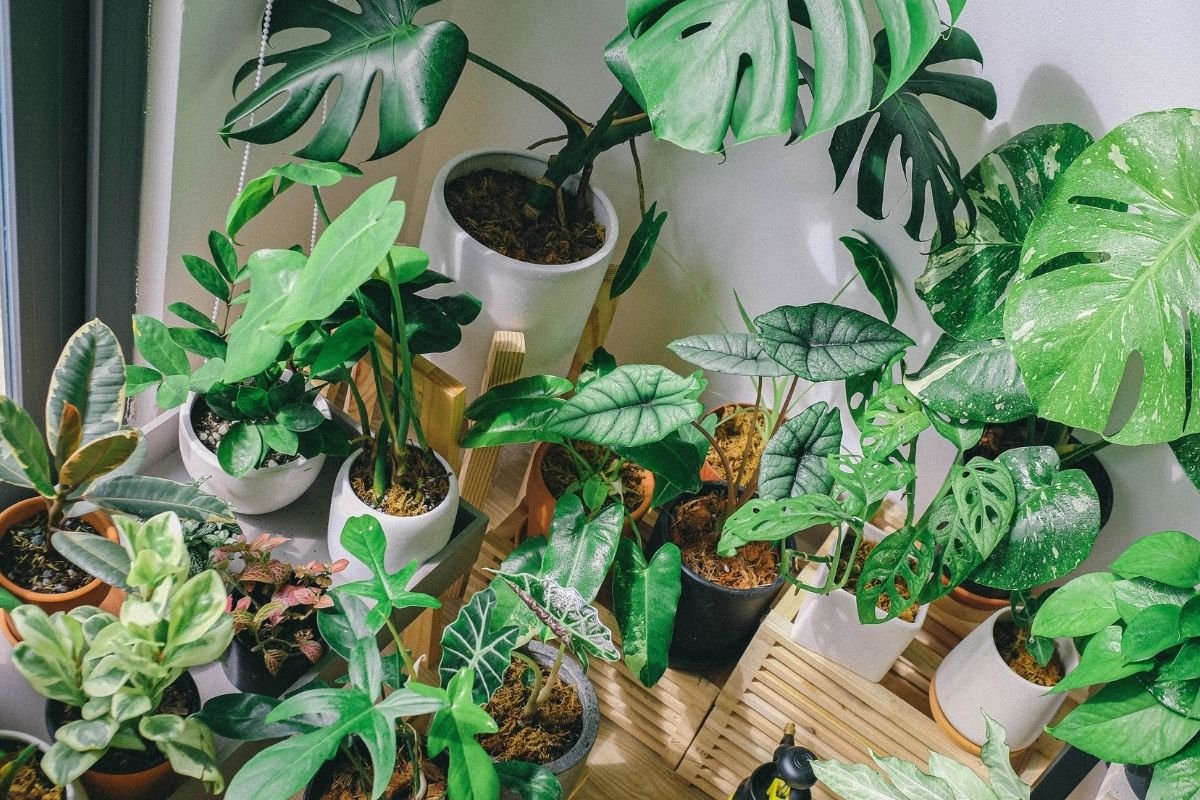
I know, I know – #apartmentproblems. If your plant isn’t getting enough light where it is, you should consider moving it to a location where it would get lots of bright, indirect light. This might be closer to a bright window or in another room altogether. However, you may have limited options if you live in a lower-level apartment – or, if you simply like the plant where it is in your space. If either of these things is true for you, hang a spot grow light near your plant to deliver just the right amount of light to your monstera.
More about lighting
- How To Use Grow Lights For Indoor Plants
- 5 Best Grow Light Strips For Indoor Plants
- Our *hands on* MARS HYDRO TSW 2000 review (with photos)
- Understanding weed light cycles: Get the most from your harvest
- Indoor plant lighting guide: where to put your plants
- How close should grow lights be to plants?
- Best grow lights for seedlings: how to sprout your seedlings safely
- Guide: full-spectrum light for plants (+grow light spectrum chart)
- 10 best LED grow lights for indoor plants

